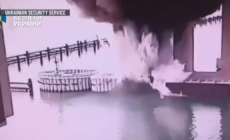-
Thunderstorms sweep across SoCal, bringing dangerous dry lightning - 25 mins ago
-
Ukraine says it struck a critical Russian bridge with explosives - 28 mins ago
-
Jessica Alba lounges poolside in bikini while promoting friendship and self-care - 31 mins ago
-
How to Watch Dallas Wings vs Seattle Storm: Live Stream WNBA, TV Channel - 34 mins ago
-
Who are the top 10 players from the 2020 NFL Draft? - 36 mins ago
-
South Dakota mother sentenced after letting her disabled son ‘rot’ in motel room - 56 mins ago
-
How ‘Karate Kid: Legends’ is Connected to ‘Cobra Kai’—And Which to Watch First - about 1 hour ago
-
New searches underway in Portugal near where toddler Madeleine McCann disappeared in 2007 - about 1 hour ago
-
Trea Turner, Bryce Harper go yard as Phillies strike first vs. Blue Jays - about 1 hour ago
-
McDonald’s Snack Wrap is returning to U.S. menus. Here’s what to know. - 2 hours ago
US Simulates Missile Strikes on Warships at China Choke Point
The United States has conducted a simulated military operation using anti-ship weapons during a war game in the Philippines, as China expands its naval presence in nearby contested waters.
Newsweek has reached out to the Chinese Defense Ministry via email for comment.
Why It Matters
The Philippines—Washington’s mutual defense treaty ally—is part of the First Island Chain, along with Japan and Taiwan, under the U.S. containment strategy, which seeks to restrict China’s naval access to the wider Pacific Ocean by leveraging America-aligned territories.
According to a Pentagon assessment, the Chinese military has the largest navy in the world by hull count, with more than 370 ships and submarines in service. The Chinese navy has been operating around the Philippines, including deploying an aircraft carrier in late May.
During the ongoing Exercise KAMANDAG 9, the U.S. military deployed the Navy-Marine Expeditionary Ship Interdiction System (NMESIS) to the Philippines’ Batanes Islands in the Luzon Strait—a key gateway for China to access the waters east of the First Island Chain.
What To Know
The U.S. Marine Corps said that it had strategically positioned the NMESIS—a ground-based launcher armed with two Naval Strike Missiles with a 115-mile range—on Sunday on one of the Batanes Islands for simulated maritime interdiction during KAMANDAG 9.
Maritime interdiction is defined by NATO as a naval operation intended to “delay, disrupt, or destroy” enemy forces or supplies en route to the battle area. The simulated operation was part of a rehearsal to secure and defend key maritime terrain, the U.S. Marine Corps stated.
Following insertion by a transport aircraft onto the island, the anti-ship weapon was remotely operated from the airfield into a concealed position to interdict maritime targets, the U.S. Marine Corps added, supporting the maintenance of open sea lines of communication.
Meanwhile, a “kill web” was formed to conduct maritime strikes, employing intelligence, surveillance, and reconnaissance assets to “find, fix, and track” targets. According to the U.S. Marine Corps, no live-fire was conducted during each fire support rehearsal.
Cpl. Malia Sparks/U.S. Marine Corps
This simulated Maritime Key Terrain Security Operation (MKTSO) was carried out by the Third Marine Littoral Regiment, a Hawaii-based U.S. Marine Corps unit that specializes in amphibious and littoral, or shoreline, warfare operations and deploys across the Indo-Pacific region.
In late April, the U.S. conducted another MKTSO using the NMESIS on Batan Island, simulating anti-ship strikes. The event coincided with the transit of a Chinese aircraft carrier through the Luzon Strait, moving between the Philippine Sea and the South China Sea.
What People Are Saying
The U.S. Third Marine Division said: “The synchronization of U.S.-Philippine forces during the KAMANDAG 9 MKTSO showcased the increased ability of the partnered militaries to coordinate complex, all-domain operations and further demonstrated the ironclad U.S.-Philippine alliance.”
Lieutenant Colonel Patrick Schrafft, U.S. Third Marine Littoral Regiment’s fire support coordinator, said: “The constructive kills executed during the KAMANDAG 9 MKTSO are yet another example of the [Third Marine Littoral Regiment]’s proven value proposition to the Combined and Joint Force.”
What Happens Next
The U.S. is likely to continue its military exercises with the Philippines featuring anti-ship weapons to counter China’s naval threat. It remains unclear whether the NMESIS will stay in the Southeast Asian nation after Exercise KAMANDAG 9 concludes on Friday.
Source link


























